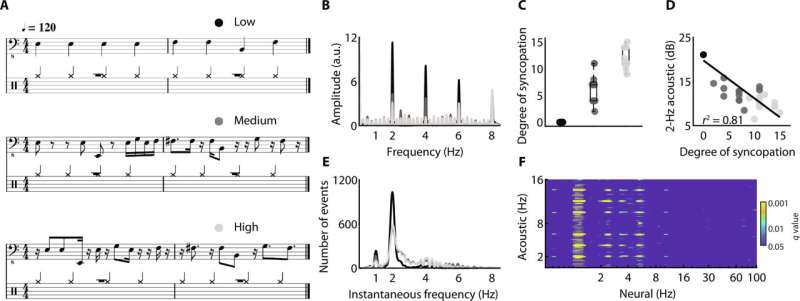March 27, 2024 report
This article has been reviewed according to Science X's editorial process and policies. Editors have highlighted the following attributes while ensuring the content's credibility:
fact-checked
peer-reviewed publication
trusted source
proofread
Why some types of music make people want to dance more than others

A trio of neuroscientists at Aix Marseille Université in France, working with a psychologist colleague from the University of Connecticut in the U.S., has discovered what they believe to be the mechanism in the brain that controls the desire to dance prompted by music. In their study, published in Science Advances, the group conducted three separate types of studies to explore the brain's reaction to music and a subsequent desire to dance.
To better understand the brain's response to music, the research team focused on both syncopation and the beat—syncopation comprises unaccented beats that occur in surprising places in a melody. The beat is the pace at which music is played, divided into even units of time.
The researchers recruited 60 adult volunteers who listened to 12 melodies with different degrees of syncopation and asked them to rate each based on their desire to get up and dance. They found that melodies with a medium degree of syncopation caused the strongest desire to dance.
The researchers then recruited 29 adults who wore helmets that allowed for magnetoencephalography while they listened to different kinds of music. The researchers found that the auditory cortex primarily focused on rhythm, while the dorsal auditory pathway appeared to match the rhythm to the beat. This, the researchers suggest, indicates that the music-prompted desire to dance likely happens within that pathway, from which it is then passed on to motor areas that act on the impulse.
Next, the researchers modeled their findings using quadratic relationships, finding that when hearing medium levels of syncopation, the brain is at a point where it can still pull the periodic beats from the melody—at higher levels, it would become overwhelmed.
The researchers suggest their work cumulatively shows that the sudden desire to dance prompted by music with a medium amount of syncopation is the brain's attempt to anticipate beats among the syncopation—it causes the body to literally lean forward repeatedly.
More information: Arnaud Zalta et al, Neural dynamics of predictive timing and motor engagement in music listening, Science Advances (2024). DOI: 10.1126/sciadv.adi2525
© 2024 Science X Network




















